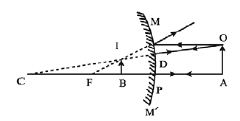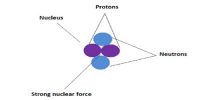Depending on the position of the object in a concave mirror, real or virtual images are formed. But a virtual image of an object is always formed in a convex mirror. The image is always erect and smaller in size than that of the object. In below figure MPM’ is a convex mirror whose centre of curvature is C, the principal focus is F and P is the pole. The object AO is placed perpendicular to the principal axis in front of the mirror.

From the point O, the ray OM incident parallels to the principal axis of the mirror. After reflection the ray seems to diverge from the principal focus F of the mirror.
Another ray OD incident perpendicularly through the centre of curvature and reflects back along the same path. If these two diverging reflected rays are extended backward, they intersect at the point I and appear to be coining from the point I, therefore the point I is the virtual image of the point O. Now perpendicular DB is drawn on the principal axis from the point I. This BI is the virtual image of the object AO. Since the image is formed behind the mirror, it is virtual, erect and smaller in size in comparison to the object. If the object is gradually brought nearer to the mirror, the image will also be displaced nearer to the mirror and the size of the image will increase gradually. But the image will always be smaller in size than that of the object.










